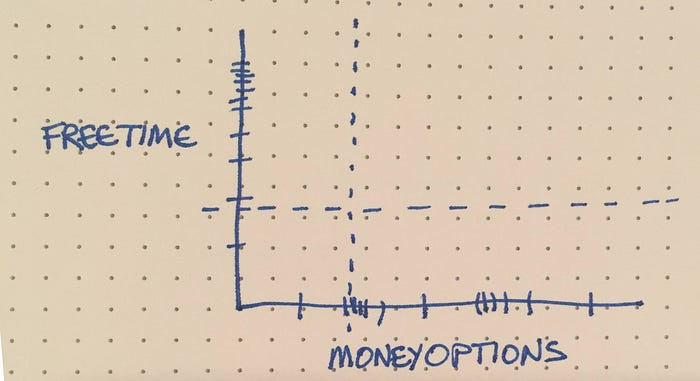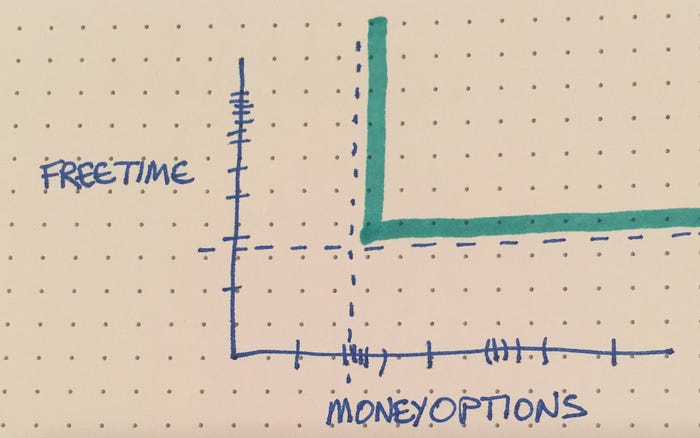Originally-originally published February 2018. Republished 2022. Newly relevant & speaking to a new audience. It’s apropos our recent conversations around developer “productivity” metrics. It’s also apropos all the changes in my business life.
I went through a period of intense anxiety around finances about a year ago. I’ll write more about that later. I felt uncertain. Nothing I did made any measurable difference. And I built habits that made the whole situation worse over time. This republication is me reminding myself of context.
I read How Will You Measure Your Life by Clayton Christensen late last year. I liked the idea of living according to consciously chosen goals. However, the engineer in me wanted to know about the units of measurement. I was dissatisfied that I couldn’t find metrics that I thought would help me live my life better.
The question—How will you measure your life?—seemed right on point. I didn’t know the units. Until yesterday.
Unmeasurable
A theme of the book is that many of the things that make life worth living aren’t measurable at all, or if they are measurable then they aren’t comparable. How many dinners with family equal one random act of kindness?
My goal in this note is to inform my intuition, not create some pseudo-precise metrics for living. I want to:
Rapidly reject dominated options, those that are worse in every way than some other option.
Use my creativity to seek dominating options, those that are better in every way than other options.
Make conscious tradeoffs between things that matter to me when a tradeoff is unavoidable.
Thanks to today’s sponsor Tuple.
Tuple is developer-grade screen sharing, for pairing and more. They interviewed me for the Distributed podcast, and I went deep on software design as an exercise in human relationships and distributed work. Check it out here.
Measuring
Just because many things that matter for a life well-lived can’t be measured or compared doesn’t mean that nothing that matters can be measured and compared. I’ll walk you through my thinking so you can think of your own axes and how they relate. I have chosen two axes of measurement that matter to me:
Moneyoptions — not money itself, but rather the options that money creates for me.
Freetime — time I use as I choose. When I wake up & my calendar is empty & I say, “What do I want to do today?”, that’s freetime. [ed: I have ~2 days a week of this & I love it!]
Moneyoptions
The first axis of the tradeoff is financial. However:
It’s not linear. Two dollars are not necessarily twice as good as one dollar.
It’s not about money. It’s what the money lets me do that I care about.
Say you are living paycheck-to-paycheck and you find a way to start saving. When you finally have a six month cushion in the bank, you have new options you didn’t have before:
A long job search
Retraining
Relocating
Having a twelve month cushion in the bank is twice as much money, but it’s not twice as good. The first, say, $50,000 creates options. The second $50,000 doesn’t create as many options. Keep saving, though, and as soon as you have enough for the down payment on a house, you have new options you didn’t have before.
Take an example from the extreme end of finances. The difference between being able to fly first class and having a private jet and pilot is maybe $10,000,000. That $10M offers me new options, but they aren’t options that I particularly care about. The absolute number of dollars is large but the value of the option is small to me. I wouldn’t be willing to sacrifice something else I care about to earn that option.
Freetime
My second tradeoff axis is freetime. “Free” means that I get to do with my time what I choose. Only part of it is “margarita in the hand/toes in the sand” time. I also want to learn organic chemistry, construct fountains, learn cartooning, code quixotic projects, read, train, play guitar, teach in Africa, & have intense conversations with interesting people.
Like moneyoptions, freetime is non-linear. Some is essential. My idea of essential might be (likely is) larger than yours. At the top end, though, the difference between 90% freetime and 95% freetime doesn’t really matter to me.
Tradeoff
Usually I draw a tradeoff as two crossing curves. In this case, though, I am finding it more helpful to plot the axes as X and Y.
Note that the axes are non-linear, representing that sometimes a little more moneyoptions is a big deal and sometimes a lot more isn’t. Same with freetime.
Each axis has a comfortable minimum.
Whatever I do, I want to stay in the top right quadrant. This was an informative part of drawing this tradeoff: I have lines I will not cross. Where those lines are and what they measure made me more conscious of my decisions. Knowing my boundaries helped me eliminate many possibilities quickly.
There will often be tradeoffs within that quadrant of acceptability, more moneyoptions versus less freetime or vice versa.
So, for example, I’m working now, vesting Gusto stock. I have less freetime this week but I hope to have more freetime & moneyoptions in the future. [ed: hard not to be bitter about this as Gusto (& the market) drags its feet about liquidity. I thought I was getting moneyoptions but I really wasn’t, I was just spending freetime. Oops.]
Conclusion
I want to emphasize that the above is an intuition honing exercise, not an attempt to superglue a veneer of rationality atop a subjective, uncertain, non-linear, and changing landscape of decisions. If something doesn’t work out, fine, but I don’t want to say, “I should have known better,” and actually be right. The value of the exercise of describing my primary tradeoff was choosing my axes, understanding that they were non-linear, setting my minima, and preparing to make tradeoffs.
I wish you a sensibly measured & thoughtfully chosen life.






I'll add that to my reading list. Curiously, in the same 2018 I was in Lisbon and went to a Sagmeister's exhibition called "The Happy Show", and I dare to say it was the most impactful exhibition I've been to. It was funny, interactive and full of great insights.
I remember him saying that the in his experience the perfect yearly wage for him was about 85k/year. Less than that, and he would have less options and less free time. Much more than that and he would start spending time to manage his money.
Great book, I've gone through it twice and hope to use it to guide more of my life.
Regarding free time, have you seen Happier Hour: How to Beat Distraction, Expand Your Time, and Focus on What Matters Most by Cassie Holmes.
From her research she says there is an optimal amount of free time, and that's the range from 2-5 hours a day, as in 3, 4 and 5 hours are just as good as 2!